What is Product Development?
Product Development is the capability that allows a company to realize product concepts and present them to customers – reliably and predictably.
It includes the entire set of activities through which a company conceptualizes, develops, and launches a concept to the market.
If you want to improve your development, check out our material on product development consulting.
A typical product development cycle includes:
Ideation
Product development begins with an idea in close collaboration with customers, whether brainstorming new product ideas, a suggestion from customer feedback, or an edict from a senior manager.
Market research and commercialization activities
To determine a market strategy, conducting thorough research and analysis is essential. A comprehensive business assessment helps evaluate the market feasibility of the product, ensuring that the product concept possesses the appropriate functionality and pricing to gain a competitive edge in the target market and support an effective go-to-market strategy.
Product design activity
This is often iterative and in collaboration with customers. In some industries, the “prototype” might be a set of manufacturing processes, a recipe for the new product.
Validation
Product designs then go through further validation, for example, to improve a user interface.
Finally, there’s the product launch and the ongoing product life cycle management activity. Product life cycle management includes the support of existing products as well as new-to-the-company products.
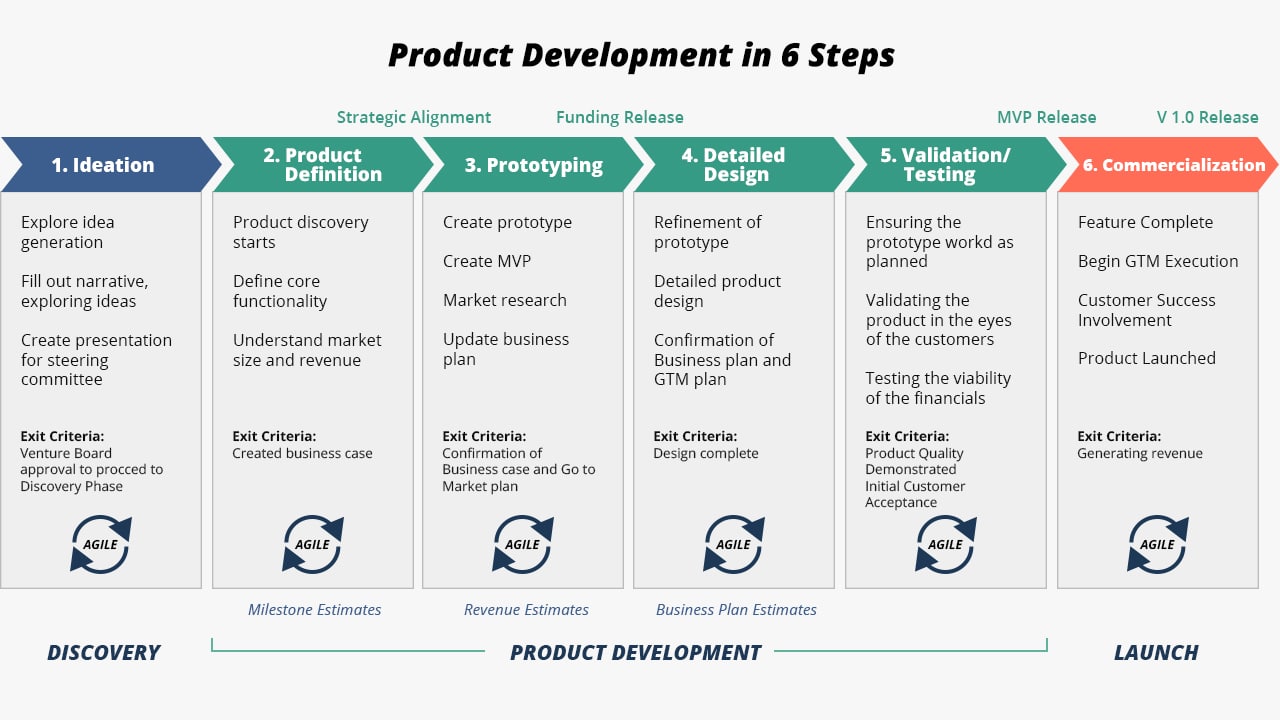
Product Development Examples
Apple
Apple protects new product concepts by separating the product design team from all other parts of the business. The team is shielded from bureaucracy and the usual hierarchy. They might even be discouraged from communicating with other employees.
The team then follows an articulated Apple New Product Process (ANPP) where the team thoroughly answers the what, who, why, how, and when questions related to the product. Apple’s methodology depends on iteration. They will continue to test and revise new products even after moving to the manufacturing phase.
Design teams report directly to the executive team. On Mondays, the executive team meets to review the products currently in development. When products move from design into production, an engineering program manager and a global supply manager take over the manufacturing cycle.
Each product has an elaborate product launch plan held strictly in secrecy. This action plan is called “Rules of the Road” and contains everything required for the commercialization and launch of the final product.
The tech giant uses a Design Sprint approach for new products. Each brief sprint conducts an experiment that the team hands over to the next sprint to move the product to the finish line.
This approach uses five development stages led by a Sprint Master.
- Understand: The first phase is to comprehend the challenge. Teams brainstorm and conduct short, fast meetings to generate insights that define the end-user’s problem. The critical acronym is HMW (How Might We).
- Sketch: Sketching is one approach to ideation. Each team member is left alone to sketch their solution to the user’s problem. The team then meets, and members share their ideas. The team votes on the ideas and eliminates some.
- Decide: The team then attempts to decide which idea is the best solution for end-users. If the team does not agree, they might use a Decision Matrix to rate solutions against many requirements. They also rate the risk vs. value proposition of the proposed solutions.
- Prototype: Proposed solutions are built out to get real-time feedback from testing. This stage involves getting rapid feedback to see what will and won’t constitute a viable product.
- Validate: The team then shows the prototype to real users, its target audience. The team may observe customers using the solution. The team then reviews and absorbs their findings together. The team leaves a trail of learnings for the next sprint, furthering the new product development project.
Kellogg
Nigel Hughes, Kellogg’s senior vice president of global research and development, summarized his company’s product development strategy in early 2021:
“We’ve revamped our whole end-to-end innovation capability to focus on our core food design skills: investing in culinary to get closer to the real food experience; sensory, to equitably learn with the consumer; a design studio and rapid process lab to speed up our prototyping; a scaled-up pilot, which is now certified to make salable food; and finally, our Menuvation Center at The Hatchery in Chicago to showcase our foods with partners and customers.”
“These changes give us a real leg up on the competition because they allow us to hit trends, influence new trends, and grow our business. They’ve transformed our ability to innovate.”
New Product Development Process (Including Agile)
Most companies follow a product development process, often divided into stages, phases, or steps. The most common product development processes have six such phases. A traditional new product development system has more checkpoints, typically towards the end of development, to ensure the product is ready for mass production and the marketplace.
For those starting or smaller organizations, we advocate reducing the steps to three:
- Concept Fit
- Product/Market Fit
- Development
This three-step approach is a Minimum Viable Process: enough process but not too much. This three-step process enables executive oversight at the inflection points where they must make investment decisions. It then guides the product team toward reducing risks. Agile organizations, or those that develop software primarily, may want to consider Agile Product Development to get the best of both Agile and Waterfall methods.
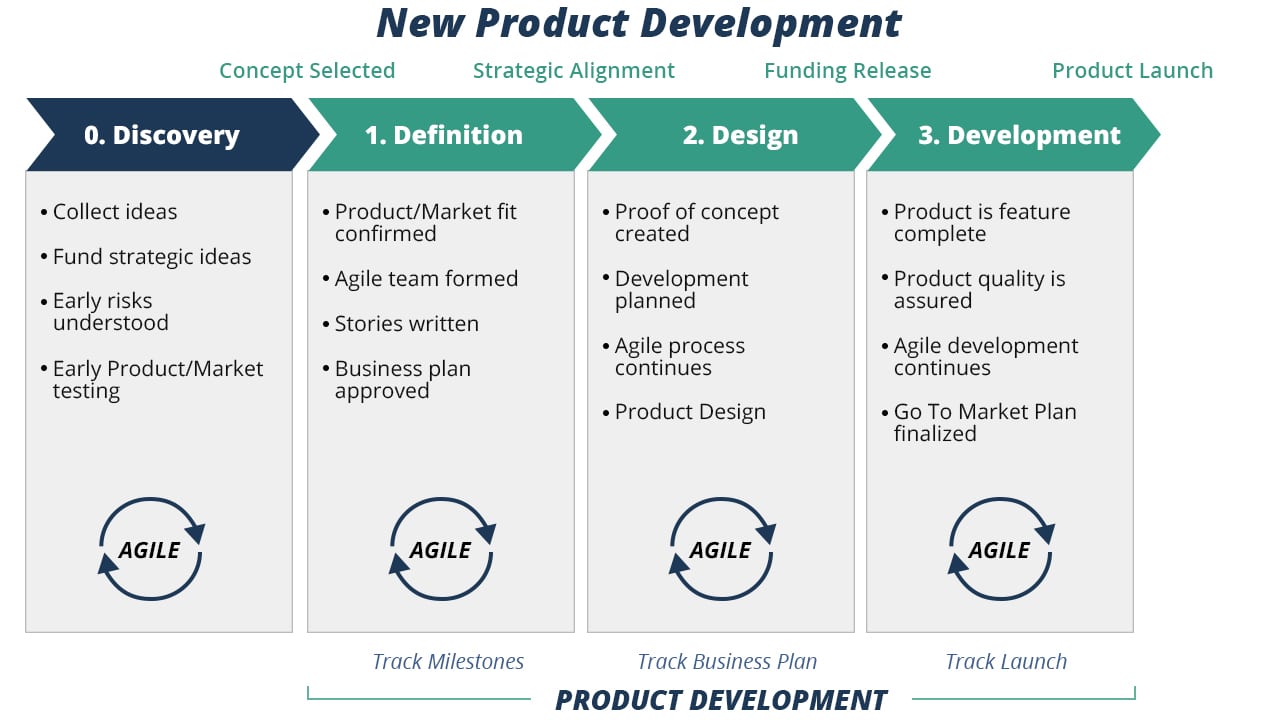
Product Development Strategy
Another aspect of product development is product development strategy. Product development strategy connects product development to corporate strategy in every possible way: from the technology hub of your company to the core, augmented, and transformational products you offer to distribution channels, geographic segmentation, etc. This is often called product development life cycle management.
A viable product development strategy begins with the following:
- A vision: a broad statement of where you’d like your company to be (3-5-year horizon)
- A strategic plan for product development: steps and initiatives you intend to take to achieve that vision (2-3-year horizon)
- Product and technology roadmaps, project priority lists, and budgets connected to specific programs that realize the strategy
Early Stage Product Development, including Ideation
At the beginning of the product life cycle, before a formal product team (or agile scrum) is started, product management leads the initial stages, with increased emphasis on business analysis, market research, and target market definition. The product strategy and market strategies are refined from this work, and the product roadmap is updated. The increasing role of AI in products and the use of social media for markets should be considered in the early stages.
In this early stage, for both agile and waterfall development, some typical elements are often done in sequence and often led by product management or, in some cases, project management. These actions, including identifying and analyzing use cases, may also be defined in more detail in a product management process if you have one.
Idea screening (Ideation)
The first stage is to come up with an idea for the product. This can come from a variety of sources, including user feedback, market research, brainstorming, or from the engineering team.
Concept development
Once an idea has been generated, the next step is developing a product concept. This involves creating a high-level product description, including its key features, benefits, and value proposition.
Market research
This can involve analyzing customer needs and preferences, studying the competitive landscape, and identifying potential sales channels. This work helps to align the product strategy to serve the market strategy.
Business analysis
Once the concept and market have been defined, conducting a business analysis is essential to determine whether the product is technically and economically feasible to launch.
Product roadmap
Lastly, the product manager should update the product roadmap to lay down the major releases, features, and timelines for your product development.
New Product Development (NPD)
New product development, adequately understood, is the design, development, and launch of new-to-the-world products. It involves three capabilities:
- Having the proper governance to protect, fund, and nurture novel product concepts
- Sufficient funding to allow these ideas to grow
- A process for vetting and prioritizing them to select and launch only the best ideas
Product Development Life Cycle (PDLC)
The Product Development Life Cycle (PDLC) Stages describe the many activities that occur from the initial conception of the product to when the product is in market.
- Introduction: Where the product concept is created and launched
- Growth: Where the product marketing team takes over and maximizes penetration and sales
- Maturity: Here, the product marketing team tries to maximize profits, and the product management team tries to continue to evolve the product
- Decline: At some point, all products retire and are replaced by higher capability/newer technology versions
Product Management for Product Development
Product management is often the leading role in product development. To a large degree, product managers lead because there is often so much market risk that they are needed to guide the concept development and concept testing early in the process – even before test marketing.
Besides playing an important role early in the product development cycle, they also guide the formulation of a so-called Minimum Viable Product (MVP) to wring out any product-market fit early in development. MVPs are often used for software development to ensure the market values the new features.
Product management for product development includes such tools as:
- Product roadmaps that show how new and existing products will evolve about one another
- Tools for tracking milestones and keeping new products on schedule
- Templates for keeping roles and responsibilities straight & stakeholders involved
- Product development metrics that measure the behaviors that improve your process
- Business plans to model the projected sales and profit to justify investment
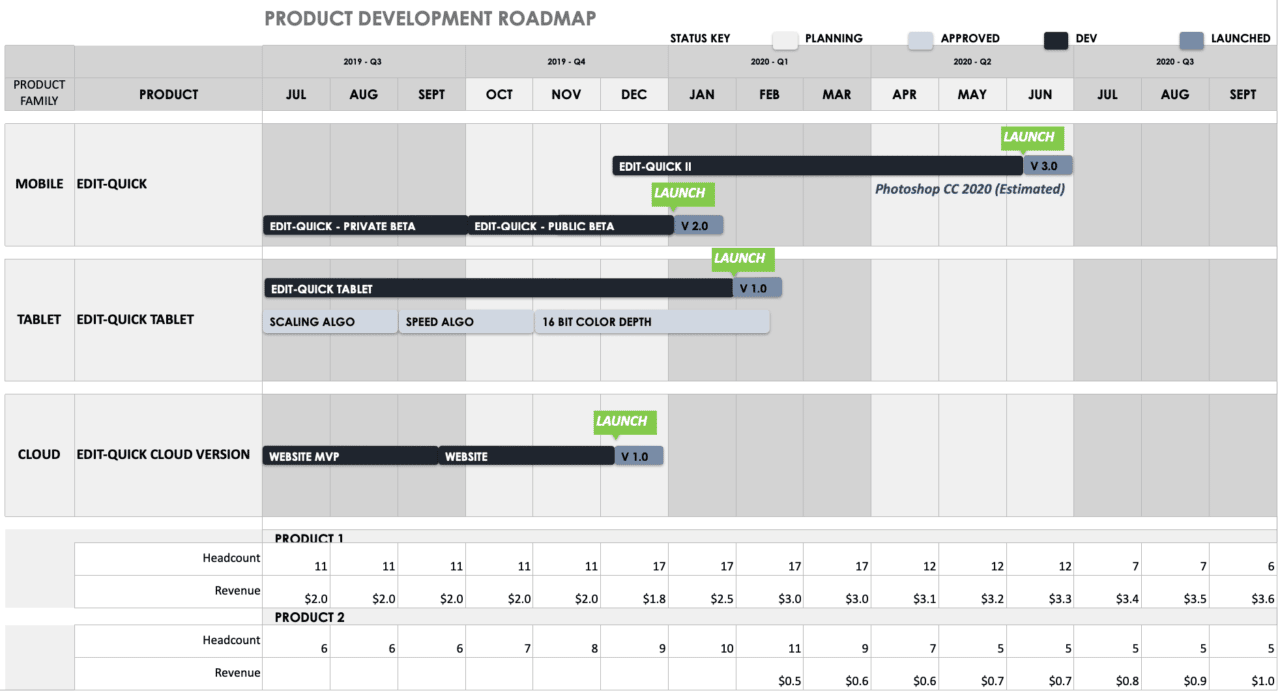
Organizing Product Development
Cross-functional teams often come together to develop a new product and then disband, with their resources assigned to other projects. The leader of the development team is usually a Product Manager or Product Owner. At the same time, the senior management in question might include the CEO, CMO, CTO/CIO at a startup, or Directors at a larger company.
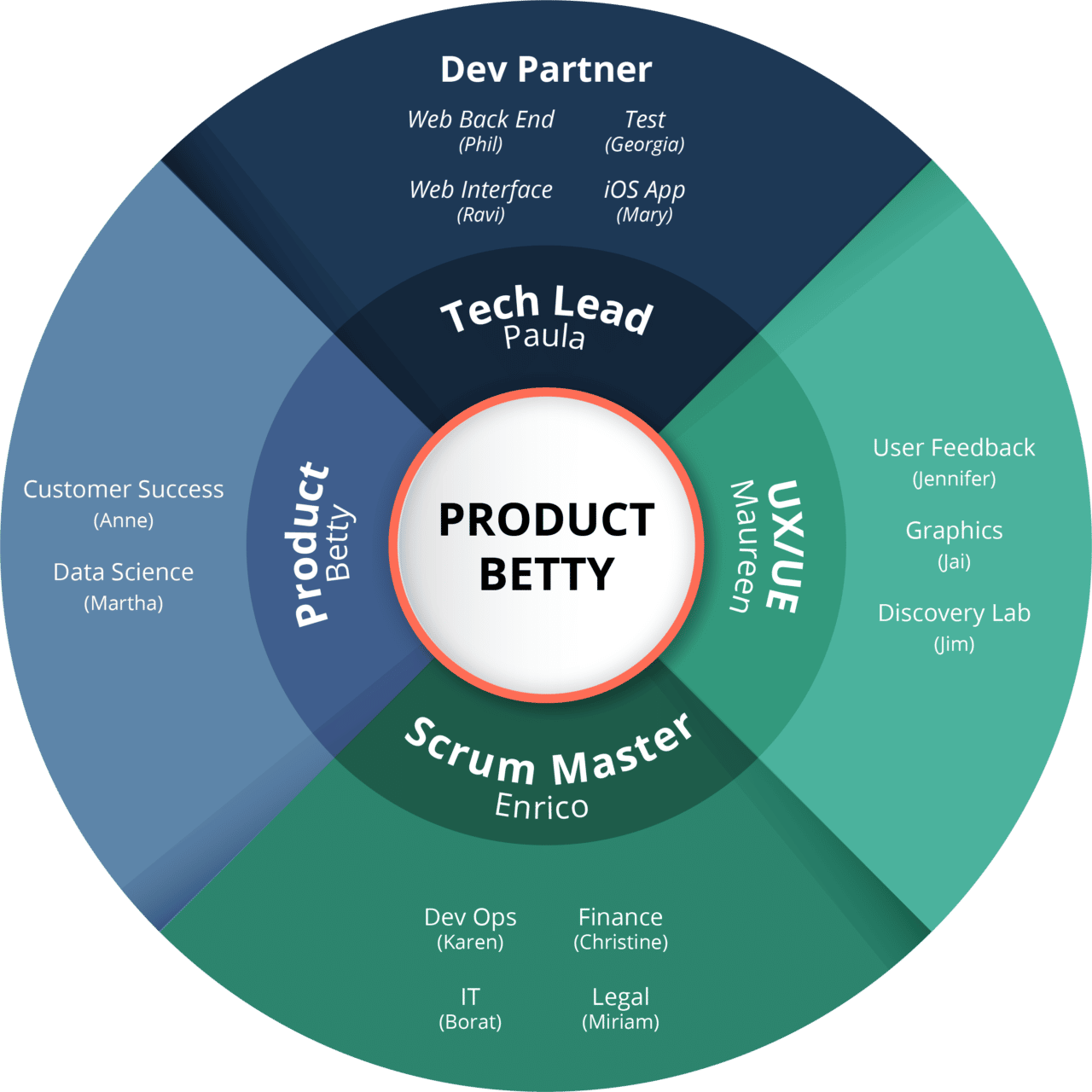
The best way to organize projects is to have an empowered development team with broad decision-making authority within pre-established parameters. This exception management approach includes a clear and straightforward escalation process when projects drift away from predefined quantitative targets.
Agile product development teams are one way to get an empowered team with a straightforward customer focus through relentless interaction with customers in tandem with product development activities.
In this approach, at the beginning of a project, the dev team and senior management agree on the key dimensions that will make a successful product. These agreed-upon dimensions of the project might include certain must-have features, a target dev cost, measures of quality insurance, a desired velocity, and a timeframe for the project (see figure below). It is worth acknowledging that there are good and bad ways to control a project.
Companies that succeed with product development also have a strong culture of senior management sponsorship of new ideas. These firms have senior managers aware of early-stage products and create a protected space to nurture them. They champion the best ideas from the beginning, giving them the funding and resources they need to succeed.
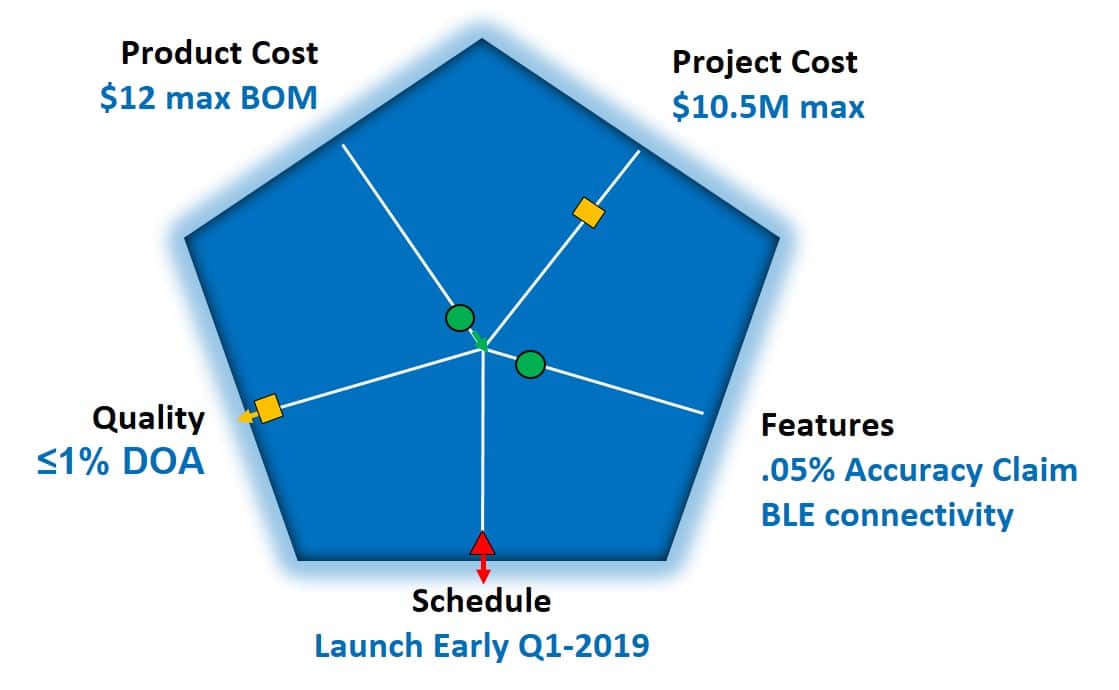
Tips for Improving Product Development
Have a long-term vision
Product development requires patience. Past the startup stage, a “quick win” mentality won’t get the startup stage done. Creating a stream of new products over a long period necessitates a vision, a strategy that defines how your company will get there, and the budgets and governance structure to support and execute the strategy.
Integrate technical and customer perspectives into the executive team leading product development
Tech companies tend to be tech-driven. However, the right executive team to serve as a board for approving product development investments should include technical and customer (Product Management) skill sets. Ensure customer and market needs are present when leaders decide on product development, especially product selection.
Support product development with appropriate funding
Sure, it’s essential, but how many companies nurture early-stage product development to get the best return from their product portfolio? Teams require seed funding on the front end for idea generation, and the prototyping and iterations needed to envision a final product. Remember to fund the first stages, where new product concepts grow into fully-fledged offerings in the marketplace.
Create a product portfolio strategy
Companies that create a stream of new products allocate their investments strategically within a portfolio of offerings. Divided between their core business, products in adjacent markets, and innovative new products. Companies determine these investments strategically, often based on the company’s risk profile.
Make sure the organization is right-sized for the task
Effective product development depends upon sufficient resources. In larger companies, too many resources are often committed to maintaining existing products, and the skills needed for tomorrow’s products are limited. Also, too many vital resources, like a coder with specialized skills, are overloaded. The right mix for product development is to have these critical contributors on at least two projects at a time.
Have a method for capturing the Voice of the Customer
Whether it’s Design Thinking or some other methodology for capturing the customer experience, it is essential to have a lifeline for potential customers. It is also important to translate the customer’s voice into the design process with the features most valued by the target audience.
9 Essential Product Development KPIs to Drive Business Growth
Product development KPIs, or key performance indicators, are specific product management metrics that track and monitor business goals and give vital insights into the product development process. They are a …
A Brief Guide to Engineering Product Development
New product development or NPD is the process by which businesses create new and innovative products for their customers with the hopes of gaining a competitive advantage. Businesses usually follow …
All You Need to Know About Pharmaceutical Product Development
New product development (or NPD) in the pharmaceutical industry can be a complex and difficult process. Statistics show that the R&D budget allocated for developing new drugs is five times …
Attitude Influence Diagram: Eliminating Political Roadblocks
Have you ever had an excellent product concept derailed by internal politics? It is frustrating since good ideas that could benefit the company as well as the individuals involved are blocked for irrational causes. The Attitude Influence Diagram is one tool that helps to overcome political obstacles.
Building High-Performance Teams To Drive Innovation
Creating high-performance teams is a competitive advantage. Through high performance teams it is possible to quickly innovate and deliver winning products to market.
Circle Dot Chart: Clarifying Responsibilities
Sorting out who does what on a project is pretty basic. Clear tasks with clear responsibilities and deadlines is Project Management 101. But how many projects have you managed where it was unclear who was responsible for a deliverable until it turned into a mess? The Circle Dot Chart addresses this issue.
Comparative Funding Models: Funding Innovation Programs
Most businesses today are looking to take advantage of innovation to drive revenue growth, but they lack methods to fund the R&D expense necessary to support expansion. Use this handy visualization tool to fund innovation programs.
Cosmetic Product Development: 4 Simple Steps to Launch Your Successful Beauty Product
The beauty industry is growing at a rapid pace. A report by Allied Market Research suggests that the global cosmetics market will grow to $463.5 billion by 2027 with a …
Digital Product Development Process: A Complete Breakdown
Every business owner sets out to achieve one thing with their business: success. If there’s one thing that distinguishes successful businesses from unsuccessful ones it’s innovation through New Product Development …
Dot Voting – Evaluating Ideas, Prioritizing Action
Dot Voting is a process in which a team can take a large amount of data and quickly gain focus on the most relevant elements based on the team’s shared analysis.
Empowering Teams Through Metrics at Apple
Four times Apple tried and failed to adopt a consistent product development process. We established a target metric with the aim of seeding the changes within the organization so that they took root.
Escalation Process In 4 Steps With Escalation Template
The Escalation Process clarifies the boundaries and channels of decision-making throughout an organization. Designed around the concept of a core project team, the Escalation Process diagram displays a path that allows the core team to make decisions at lower levels of the org chart while having a predefined path for exception management.
Execution: Quickly Estimating Accurate Project Schedules
The Lite Schedule Estimating Matrix is a tool that helps to estimate the amount of time a project will take in any given phase. It leverages past experience combined with the critical few, key drivers that impact a project’s schedule.
Fashion Product Development: A Complete Guide
The fashion industry is as fierce as ever, every dollar spent, at every stage matters. Fashion product development helps to create innovative products catered to customer needs to gain a …
Forecasting the Future
The Improvement Forecaster consists of an equation, and a graphical plot of expected improvement over time. It uses estimated degrees of technical and organizational complexity, and based on prior programs, estimates a rate of improvement.
Getting a Project Back on the Rails
Setting “boundary conditions” at the time of a project’s approval is an effective way to create a “contract” between the management and project teams.
How do you quantify the probability of success of a new product?
The best way to estimate the probability of success is a combination of internal factors and an understanding of the competitive structure of the market environment. Triangulation provides the most reliable guidance with the least effort.
How to Develop a Successful Food Product in 2023 (Complete Process + Steps)
With the wider adoption of technology throughout industries, companies seem to be making more innovative products than ever before. The food industry seemed like the last place for a formal …
How to Manage Risk Proactively
In new product development, innovation may entail technical risk, market risk, risk relating to outside partners, or events far beyond your control. No new product development program can avoid risk. However, much more than business-as-usual can be done to anticipate and mitigate risks proactively.
Lean Product Development: An Introductory Guide
What is Lean Product Development (LPD)? Lean product development is a refinement in development methodologies based on cross-functional planning and collaboration. It eliminates non-value added activities and eases communication between …
Managing Project Cadence: Deliverable Hit Rate Chart
The Deliverable Hit Rate tool manages project cadence by monitoring the progress of completed tasks against a target over time.
Market Development VS Product Development: Definition & Key Differences
Having an efficient long-term strategy is essential for businesses to expand and grow. Planning to expand and grow operations, however, is easier said than done which explains why 50% of …
Medical Product Development: Creating a Successful Medical Device
New medical device development is the way for medical device manufacturers to encourage innovation and provide unique solutions to customer needs. However, in the medical industry due to strict regulatory …
Need to improve team performance? Find and Correct the “Pinch-Points”
Pitch points for Teams that develop new products and are challenged to produce a high-quality, valuable solutions in as short a time as possible and within budget.
New Product Development (NPD) | 6 Stages, Company Examples | TCGen
What is new product development (NPD)? New product development is the ideation, design, production, pricing, and launching of new products to your target customers to provide a solution that addresses …
New Product Development | Creating Great Products | TCGen (new)
What is new product development (NPD)? New product development is the ideation, design, production, pricing, and launching of new products to your target customers to provide a solution that addresses …
New Product Development Process
What is a New Product Development Process? A New Product Development Process refers to the entire range of activities where a company conceptualizes and realizes a new offering, often based …
New Product Development Process At Apple (4 Steps) | TCGen
Learn about the new product development process at Apple including the major issues and four step approach to transform Apple’s new product process.
Outsourcing Map: Harnessing the Global Workforce
You may have decided to outsource or offshore some of your product development or other business processes. But how do you decide what processes to outsource and what partners to use? This tool helps you select the right resources.
Predictive Metrics Tree: Measuring the Behaviors That Drive Results
The Predictive Metrics Tree is a tool that ensures that what you’re measuring helps you achieve your program goals. Learn to create Predictive Metrics Tree.
Product Development Checklist
The fastest way to destroy an Agile implementation is to let functional silos get in the way. Unfortunately, it happens all the time. And it happens because many companies underestimate the organizational implications of a successful Agile implementation.
Product Development Life Cycle: The 4 Stages Explained
What is Product Development Life Cycle Management? The product development life cycle describes the 4 stages of a product’s life: 1. Introduction, 2. Growth, 3. Maturity, 4. and Decline. It …
Product Development Metrics Consulting
Too many companies are measuring the wrong things, in the wrong way, and ending up with the wrong results. Product Management capability is emerging as one of the most important …
Product Development Metrics Tools
These product development templates are based on real life examples, and have been tested in the field with clients on multiple engagements. We often are stuck when first getting started …
Product Development Process Tools
These product development templates are based on real life examples, and have been tested in the field with clients on multiple engagements. We often are stuck when first getting started …
Product Development Roadmap: Tips For Making Agile Roadmaps
What is a product development roadmap? Product development roadmaps provide a visual explanation of a company’s strategy. They link the product vision with development. They help align Engineering, Marketing, Sales, …
Product Development Strategy | Examples from 8 Companies
What is a Product Development Strategy? A product development strategy guides new product development or existing product changes to maximize sales. Product development strategy can be a subset of corporate …
Project Efficiency: Getting More Done by Doing Less
Managers want to optimize their resources by loading them up and have them do more on the priority list to satisfy the executive suite. The optimum load is approximately 2 projects – one large and one small.
Risk Management Matrix: Anticipating and Mitigating Risk
You can’t take the risk out of invention and no project is completely risk-free. But you can reduce the risk, even in the most innovative programs. How? By anticipating it. The Risk Management Matrix is an elegant way to anticipate, manage, and mitigate product development risks.
Schedule Prediction Accuracy – Anticipating Problems to Deliver On Time
Measuring schedules is not new. Using this graphical tool, that allows you to quickly monitor performance to the initial plan and check key drivers that can take you off course, is a new technique for many organizations.
Seven Product Development Process Lessons from BOSE’s Blockbusters
Product Development lessons learned from developing BOSE’s blockbusters products – BOSE’s Noise-Cancelling Headphones and the BOSE® Wave® Music System.
Social Community Matrix: Getting the Most Out of Social Communities
Many of our clients are using virtual communities to communicate and collaborate with outside partners. Managed communities enable you to share ideas and present the best proposals to the leadership team. Here’s a tool that helps select the best type of community for your needs.
Software Product Development: Definition, Importance, and Complete Process
Software is a part of our everyday lives. It’s what runs our phones, computers, cars, and other products. But, despite the wider adoption and understanding of technology, as many as …
Software Product Management – Staffing Ratios
Product Management is often an understaffed, overworked function. And the impact on the organization is huge.
Staffing Ratio Matrix: Optimizing Workloads Across Functions
The Staffing Ratio Matrix contains a summary of all the projects in a given function, charted against the key functions found on a cross-functional team.
Stop Measuring Results: Start Measuring Predictive Indicators First
Companies are producing the wrong results, because they’re measuring the wrong things. If you want to ensure long–term success use short-term predictive metrics to quickly inform you that you’re on the right path.
Technology Roadmaps: Anticipating Future Technology Trends
The Technology Roadmaps ties technologies & product timetables together by indicating which core technologies will be mature enough to incorporate into a particular product release.
The Best New Product Development Process [Definitive Guide] (new)
What is a Product Development Process? A Product Development Process refers to the entire range of activities where a company conceptualizes and realizes a new offering. A product concept might …
The Function Phase Matrix: Clarifying Roles and Responsibilities
The Function Phase Matrix helps clarify cross-functional team objectives, roles and responsibilities. It tracks key deliverables across the phases of a project and identifies each function’s participation in each of these phases.
The Ultimate Guide to Electronic Product Development
Creating electronic hardware is a difficult and often exhausting task. Most hardware startups fail due to unanticipated obstacles and product complexity. According to Forbes, as many as 97% of seed …
The UX-Product Development Overlap: What Are Their Roles And How They Function Together
There are many things to consider when developing a new product in our digital world. Costs, legacy mainframe modernization, and scalability are all concerns worth thinking about. Chief among them …
Tips For Leading a Globally Distributed Group
Many of today’s leaders try to coordinate business resources that are scattered over a large geographic area – perhaps even the whole world. It is common for such people to …
Unclear Escalation Paths Can Kill Projects
At the beginning of any major project or program, defining a clear escalation path and protocols for problems will greatly speed the project.
Visualizing the Resource Gaps in Product Development Projects
Inadequate staffing or unclear priorities across organizations often leave resource gaps that throws the project off the rails. Identify the resource gaps in Project Management.
Visualizing the Unexpected
Project post mortems can be an excellent tool for learning from mistakes and implementing process and decision-making improvements.
What is the Stage-Gate Process? Pros and Cons
What is the Stage-Gate process for product development? The Stage-Gate Process divides product development into 5 stages where progress to the next stage is approved at the gate. Projects proceed …
What You Need to Know About Product Innovation Management
Technology has made it easier than ever to buy any product whenever and wherever you want. Likewise, the development of new tools and equipment means that businesses are more able …
Why Retrospectives are a Waste of Time
Preparation is key to a winning retrospective. The most important goals in most programs are time to market, a winning feature set, and quality. The best method is to collect the events that impacted these factors using a timeline.
Your Company Is Not Investing Enough in Engineering Productivity, And You Know It!
Organizations are failing to take a stake in improving product development productivity, a core process that is the engine of top-line growth.

